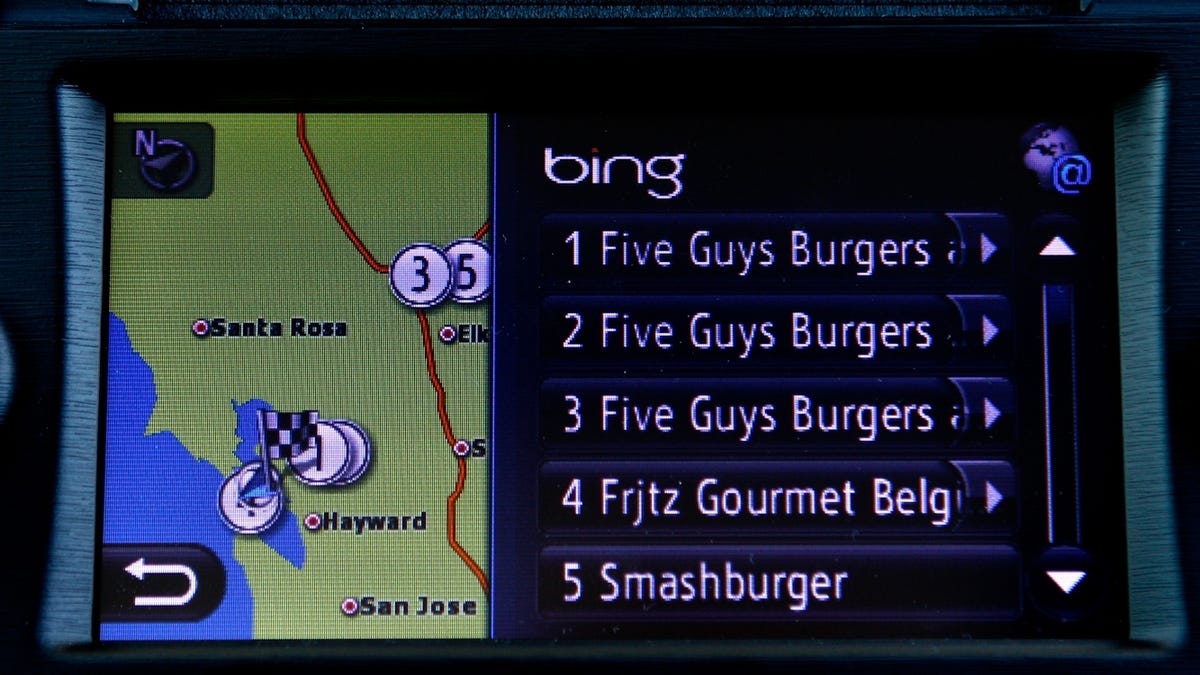I want my Google search, on the road
One of the most useful automotive navigation features, Internet-based local search, has been strangely neglected by carmakers.

Traffic data, fuel prices, weather, and even streaming music make for great connected car features, but Internet-based local search has gotten surprisingly short shrift from automakers.
In my opinion, local search is the killer feature you probably don't have.
Whether from Google, Bing, or another search engine, Internet-based local search integrated with a car's navigation system can help you find everything from hamburgers to hair salons.
Only a few automakers offer local search. When I recently reviewed a BMW 750Li, I found Google search among its BMW Online services. Audi also offers Google integrated with the navigation system in cars such as the A6, not surprising as the navigation system itself uses Google Earth maps.
Toyota includes Bing local search as part of its Entune system, which runs through a smartphone app.
Related stories
While driving down the freeway in the BMW 750Li, I entered the name of a sandwich shop and chose one from the list of results. The car then sent the address into the navigation system, and pretty soon after I was eating pastrami on rye.
Of course, most navigation systems have a points-of-interest (POI) database that includes restaurants. But these databases get out-of-date. It is very disappointing to roll up to a vacated storefront when you are hungry for lunch.
Worse, those POI databases do not usually support fuzzy logic, so you have to enter the exact name of the place you want. Here at CNET, we often use In-N-Out Burger as a means of testing POI search, as most will have trouble with common variations on that name. Internet local search can handle misspellings, is more likely to be up-to-date, and includes a broader array of businesses.
One argument against local search is the distraction factor of drivers entering business names into the search field while barreling down the freeway at 70 mph. However, drivers are already performing these types of searches in their cars' POI databases, and often not getting useful results, increasing frustration and distraction.
The ultimate solution to avoid distraction is to use voice entry with local search. Toyota models with Entune support voice search through Bing.
So why hasn't local search become common in cars?
One of the first connected car features to come out was traffic data, which was integrated with navigation systems. I remember being extremely impressed in 2006, when the Lexus LS I was driving warned me of an accident up ahead, letting me avoid sitting in a traffic jam for half an hour.
Traffic data comes to cars through satellite radio or on the FM band. Both are broadcast media not designed for a return signal.
OnStar has had a mobile data connection into vehicles for many years, but GM did not exploit the full potential of that system. As other manufacturers began to roll out mobile data connections and smartphone integration into their production vehicles over the last few years, Pandora Internet radio became the most pervasive service. You can find Pandora in cars from BMW, Buick, Ford, Honda, Hyundai, Lexus, Lincoln, Mercedes-Benz, Mini, Nissan, Scion, and Toyota.
Local search has not caught on as quickly
The fault seems mostly to lie in the difficulty of integrating a new address entry method with an existing navigation system. Most implementations of Pandora come off as an add-on, not well-integrated into the car's stereo interface. By its nature, local search would have to be tightly integrated with navigation, and thought would involve more development.
There are some services that work as a stepping stone towards integrated local search. Google Map's Send To Car feature works with models from over 20 makers, according to Google. Send To Car lets you look up a destination on Google Maps, then push a button to send it to your car's navigation system.
TeleNav is attempting to tie PC, smartphone, and car navigation together through its Scout navigation product. With Scout, you could look up an address on any of these platforms, then access it on the others. For Scout to be successful, automakers will need to integrate it into their navigation systems. Ford is the only company so far that has integrated Scout.
Beyond its aforementioned usefulness for drivers, companies such as Google and Microsoft should be champing at the bit to get their search services into cars. These companies already know how to monetize search, so expanding their reach onto another platform, a platform with heavier dissemination than smartphones among the American public, would seem like a no-brainer.
I expect we will see more and more car companies integrating some form of Internet-based local search with their navigation systems over the next few years. All the pieces are in place, and it is more generally useful than Pandora and other apps currently offered in cars.

